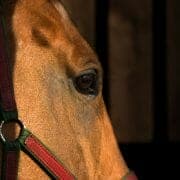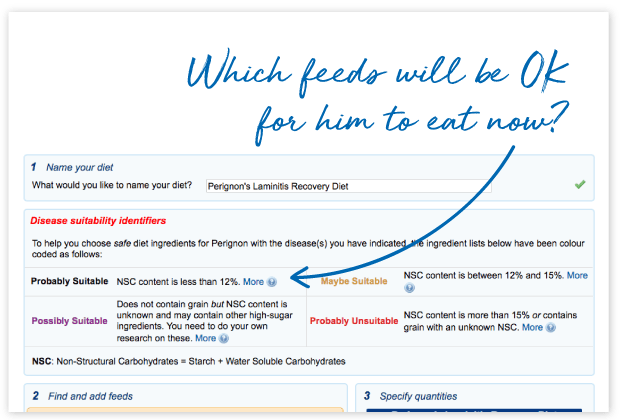Starch & Ulcers: What’s The Deal?
The connection between starch and ulcers in horses
You may have heard it recommended that horses with ulcers should be fed a ‘grain-free’, low starch diet. It is believed that any starch may make ulcers worse. Or stop them from healing when the horse is being medicated to resolve ulcers. But is there any scientific basis for what has now become a popular recommendation? Let’s take a look!
Starch is fermented to volatile fatty acids (VFAs)
Like the rest of the horse’s gut, the stomach is full of bacteria. When grains AND forage enter the stomach, they are partially fermented. During fermentation, the bacteria produce volatile fatty acids. These VFAs are the same as what is produced in the hindgut during fermentation there. So they are not harmful to the horse. In fact they are beneficial.
Thing is though, in the stomach, they get mixed with the hydrochloric acid from the stomach and become ‘nonionized’. In this state, they can enter the epithelial cells of the upper part of the stomach, causing them to become inflamed, and swell, and ultimately make the stomach wall lining more prone to ulceration. This is what they understand to happen in pigs.
So everything you feed a horse will be partially fermented in the stomach. We do know however, that when we feed a grain based, high starch ingredients, higher levels of VFAs are produced. But does it increase the risk of gastric ulcers? Not necessarily.
Lucerne + grain = less ulcers than grass hay
In a study where horses were fed either lucerne + grain OR grass hay only, there was significantly higher levels of VFA in the stomach contents of horses fed lucerne + grain. BUT, the horses on this diet had less severe and fewer gastric ulcers than the horses fed the grass hay only diet. Despite the higher level of VFAs, horses on the lucerne + grain diet had a higher pH (less acidic) for 5 hours after feeding when compared to the grass hay only diet 1.
The researchers in this study suggest the high protein, high calcium characteristics of both the lucerne hay and the ‘grain’ (unfortunately, they do not specify what the grain was except to say it contained over 7 g/kg of calcium and was almost 15% protein, so it must have been a fortified commercial feed) created a buffering effect in the stomach and were able to keep the pH higher.
So here, the starch did increase VFA levels, but the diet containing the grain was also effective at keeping gastric pH higher. Combined, there was a protective effect against ulcers.
In a second study2, researchers found that of horses fed lucerne plus a commercial pelleted feed, 8% developed ulcers. Compared to 75% who developed ulcers when they were fed the same pellet, but with grass hay. In this same study, horses that started with existing ulcers all improved their ulcers scores by more than 2 when fed lucerne + pellet. But on the grass hay, only 2 out of 12 horses showed healing to the same degree. So it does appear lucerne is protective. And that feeding grain/starch doesn’t automatically mean a horse will be prone to ulcers.
What about high fibre versus low fibre?
We tend to think that a high fibre diet is always going to be better than a low fibre diet for minimising gastric ulcers. And there are varied reports in the literature. Research from the UK3 reported that a low fibre, high concentrate (32% starch pellet) diet had a lower number and severity of lesions versus a high fibre, low concentrate diet. Odd right!
The fibre fed during this study was ryegrass haylage. A trend is starting to appear with grass forage and a higher risk of ulcers! What we don’t know is why? Researchers in Denmark reported that horses with straw as their only source of forage had a higher risk of ulcers4 which may give some clues. Perhaps there are nutrients required for maintaining gut wall integrity that grass hays and straw are unable to provide.
The important point here is to realise that just feeding lots of forage is not enough to protect a horse from ulcers. And to recognise that adding grain to diets is not a risk factor in itself. It comes down to which forages are fed and how much grain/starch is fed AND how feeding is managed.
How much starch is OK?
The studies reported above show that grain can be fed without causing ulceration. So starch is not a simple ‘Cause & Effect’ with gastric ulcers. Or in other words, when it is fed in a certain way, it can be fed without causing ulcers. And can even be fed in a way to allow ulcers to heal. But is there a limit to how much starch you can feed a horse with ulcers?
The answer is YES! In a large study, 201 Danish horses from 23 different non-racing stables were scoped for ulcers. 53% of horses were reported as having an ulcer score of more than 2, with most of these occurring in the upper part of their stomach4.
Two risk factors related to the amount of starch fed were reported in this study;
- Feeding more than 2 grams of starch per kg of bodyweight per day (equivalent to 2 – 3 kg of a complete feed/day for a 500 kg horse, depending on the feeds starch content) doubled the risk of ulcers; and
- Feeding more than 1 gram of starch per kg of bodyweight per meal (roughly equivalent to 1 – 1.5 kg of a commercial complete feed per meal for a 500 kg horse, depending on the starch content of the feed) increased risk by more than three times.
So some starch it seems is perfectly OK. But there is a limit to how much should be fed ‘per day’ and ‘per meal’.
Feeding grain based feeds carefully is a huge consideration in managing the risk of ulcers. If your horse needs more energy than can be provided by the amounts of grain based feeds specified above, you should look at feeding oils or high energy fibres to meet the rest of your horse’s calorie requirements.
Does starch cause ulcers in horses?
Too much starch increases the risk of ulcers. But when fed in a well put together diet, research has shown that diets containing grains resulted in less ulcers than grass hay only diets. So starch, itself, doesn’t appear to cause ulcers.
My horse is prone to ulcers. What should I do?
Good question! Here are my top tips on feeding a horse prone to ulcers:
- Feed lucerne hay – lucerne has been shown to buffer the stomach well and is protective against ulcers. It even seems to help them heal.
- Feed lucerne as chaff or haylage with your grain based feeds – this seems to help negate the possible negative effect of starch when it is fermented in the stomach.
- Feed lucerne hay before you ride – working horses on a full stomach is CRITICAL for preventing ulcers. The fibre stops the acid splashing around and the saliva created while chewing the hay helps to buffer the acid in the stomach. Using lucerne has the extra positive benefit with the buffering effect from the lucerne itself.
- Feed lots of forage – the more forage in the diet the better. It makes a horse chew longer, create more saliva and keeps the stomach full of fibre to help stop acid from the lower part of the stomach splashing up onto the top part and creating ulcers.
- Don’t allow more than 5 hours between meals – the longer the intervals between meals, the higher the risk of ulcers5. So make sure your horse is eating at least every 5 hours. For horses particularly prone to ulcers, keeping time without food as short as possible (no more than 2 hours) is advisable.
- If you feed grain based feeds, keep the amounts small – don’t exceed 1 gram of starch per kg of bodyweight per meal. The amount of pellet/sweetfeed/cube/grain you can feed per meal depends on the starch content of the feed. The table below shows you maximum amounts that can be fed per meal of a feed, based on its starch content, for a 500 kg horse. If you are unsure of your feeds starch content, don’t exceed 1.5 kg of feed/meal (for a 500 kg horse).
| Starch Content (%) | Maximum Amount/Meal for a 500kg Horse (kg) |
|---|---|
| 20 | 2.5 |
| 30 | 1.7 |
| 40 | 1.25 |
| 50 | 1 |
- Make sure horses ALWAYS have access to water – water deprivation has long been known to increase risk of ulcers. So allowing constant access to water is important to reduce the risk of ulcers.
Should I go grain-free?
While the studies above show us that feeding grains, in diets that also contain lucerne can result in ulcers resolving, if you are more comfortable going grain-free then it is certainly an option. Using high quality, grain-free products that are high in protein and fortified with calcium are likely going to work well for a horse prone to ulcers. As far as I can see there are no studies to confirm this… something for future research to work on!
It is just important to remember that this is not essential. Grain based feeds can be used, as long as they are used carefully.
References
- Nadeau JA, Andrews FM, Mathew AG, et al. Evaluation of diet as a cause of gastric ulcers in horses. Am J Vet Res 2000;61:784-790.
- Lybbert T, Gibbs, P., Cohen, N., Scott, B., Sigler, D. Feeding Alfalfa Hay to Exercising Horses Reduces the Severity of Gastric Squamous Mucosal Ulceration. AAEP Proceedings 2007;53.
- Boswinkel M, Ellis A, Sloet van Oldruitenborgh-Oosterbaan Mm. The influence of low versus high fibre haylage diets in combination with training or pasture rest on equine gastric ulceration syndrome (EGUS). Pferdeheilkunde 2007;23.
- Luthersson N, Nielsen KH, Harris P, et al. Risk factors associated with equine gastric ulceration syndrome (EGUS) in 201 horses in Denmark. Equine Vet J 2009;41:625-630.
- Luthersson N, Nielsen KH, Harris P, et al. Risk factors associated with equine gastric ulceration syndrome (EGUS) in 201 horses in Denmark. Equine Veterinary Journal 2009;41:625-630.
Want to try FeedXL?
Get EVEN MORE practical and personalised feeding guidance when you sign up to FEEDXL.
Do you have a question or comment? Do you need help with feeding?
We would love to welcome you to our FeedXL Horse Nutrition Facebook Group. Ask questions and have them answered by PhD and Masters qualified equine nutritionists and spend time with like-minded horse owners. It’s free!
Click here to join the FeedXL Horse Nutrition Facebook Group












